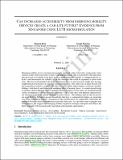Can increased accessibility from emerging mobility services create a car-lite future? Evidence from Singapore using LUTI microsimulation
Author(s)
Basu, Rounaq; Ferreira Jr, Joseph
DownloadTRL_2020_Preprint.pdf (8.713Mb)
Open Access Policy
Open Access Policy
Creative Commons Attribution-Noncommercial-Share Alike
Terms of use
Metadata
Show full item recordAbstract
Emerging mobility services are being increasingly regulated, with several cities testing car-lite policy interventions in pilot study areas before a metro-wide implementation. This study uses an agent-based LUTI microsimulation model to examine the effect of accessibility improvements on private mobility holdings, both directly and through the mediating effect of housing choice. Different market responses to acar-lite pilot are modeled through various assumptions of changes in model parameters. Three study areas with different characteristics are chosen to explore the spatial variation in policy effects. Our findings indicate that in-movers are more likely to be higher-income households with a comparatively higher car ownership rate. Unintended negative consequences like gentrification can significantly undermine the potential boosts to vehicle-free behavior inside the study area. As a possible step to mitigate such consequences, we suggest that emerging mobility regulation strategies anticipate and address the likely response of the housing market and urban redevelopment opportunities. Keywords: Emerging mobility services; accessibility; housing market; residential location; mobility holdings; vehicle ownership; agent-based microsimulation; land use-transport interaction (LUTI) model
Date issued
2020-02Department
Massachusetts Institute of Technology. Department of Urban Studies and PlanningJournal
Transportation Letters
Publisher
Informa UK Limited
Citation
Basu, Rounaq and Joseph Ferreira. "Can increased accessibility from emerging mobility services create a car-lite future? Evidence from Singapore using LUTI microsimulation." Transportation Letters (February 2020)
ISSN
1942-7867
1942-7875